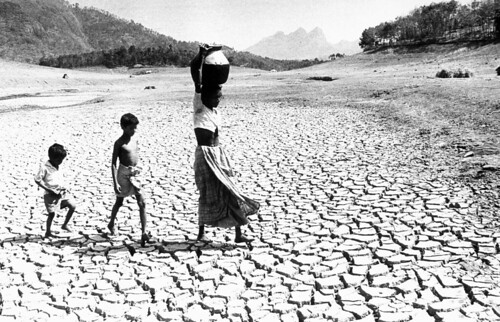Water is the only
substance on earth that occurs at ordinary temperatures in all three states of
matter – gas, liquid and solid. As a gas it is in the air around us, as vapor,
steam, fog, mist and clouds. As ice it forms snow, hail, glaciers and freezes
lakes and rivers. As liquid it covers the world in lakes, seas and swamps, or is
found deep in underground reservoirs. Depending on variables such as age,
health and geography, any human constitutes about 60% water. Humans can survive
weeks without food, but without a reliable water source our bodies start to
shut down after a few days.
Water covers
approximately 70% of the Earth’s surface, of which only 2.5% is freshwater,
and of this small percentage, only 0.3% freshwater is available in lakes and
rivers.
Growing up in England
and living in Europe there has never been a time when I've feared for my own
water security. If I was thirsty I’d merely turn on a tap or go to the shops. Such
access to water is a first world luxury and must not be taken lightly. Water scarcity is a
serious problem for millions of people worldwide.

Carrying water across the dry-bed of Neyyar resevoir, the main source of water for Trivandrum city, India.
In 1999 the World Bank
Institute Water Policy Reform Program outlined how water is essential for all aspects
of life. It highlighted that globally water availability is reaching a ‘crisis
level’ with more than 40% of the world’s inhabitants facing water shortages,
with over 1 billion people without access to safe drinking water and 3 billion
without clean sanitation infrastructure.
In the past decade this
situation has not improved and availability of freshwater continues to be a
global concern. In March 2012, UNESCO director-general Irina Bokova of the World Water Forum in Marseilles explained that fresh water continues to be a
core issue for sustainable development and that "if we fail today to make
water an instrument of peace, it might become tomorrow a major source of
conflict."
The future of the world’s
water supply is uncertain due to rising population, increasing urbanization and
the pressures of climate change. Consequently, the World Water Development
report explains that no country is guaranteed ‘uninterrupted access to water
supplies’ and the report warns that it will affect key developmental sectors
including agriculture, energy and health.
While global efforts
have been made to achieve the Millennium Development Goal of halving the number
of people that do not have access to safe drinking water by 2015 there is still
much ground to cover. By 2050 the world’s population is forecast to reach 9
billion. Rising population levels coupled with the pressures of climate change compounds the importance of ensuring greater water sustainability.
With encroaching climate change, water in some countries will increase in the form of flash floods or rising seas levels, while other countries will have unprecedented low levels of rainfall, droughts and dry rivers. Further, lakes, wetlands and rivers are under increasing pressure from multiple use, pollution and habitat degradation. Climate change and fluctuations in the levels of water will undoubtedly have a great effect on the global production of agriculture and our ability to create food and safe water for earth's rising population.
With encroaching climate change, water in some countries will increase in the form of flash floods or rising seas levels, while other countries will have unprecedented low levels of rainfall, droughts and dry rivers. Further, lakes, wetlands and rivers are under increasing pressure from multiple use, pollution and habitat degradation. Climate change and fluctuations in the levels of water will undoubtedly have a great effect on the global production of agriculture and our ability to create food and safe water for earth's rising population.
As it stands, there is
great uncertainty surrounding the amount of water necessary to sustain our
planet. Owing to climate change there is great uncertainty about what the
future will hold. To ensure worldwide water sustainability a global effort must
be made by the international community. Emerging global initiatives that have
been implemented need to be bolstered and carried out to ensure that there is
significant investment in technologies and urban water planning for the future.
Water transends both local and national concerns as everyone shares a vested
interest in a dependence on water. Water it is central to every aspect of life
on Earth and it must lie at the heart of our vision for sustainable
development for the coming century.
Two
parts hydrogen, one part oxygen; this simple chemistry is holding our world
together and we need to protect it.
I have been doing some research on Climate change and its effect on the atmosphere and space exploration. I found your post and argument to be quite interesting. I completely agree with the fact that water will be one of our biggest problems as Climate change progresses, but I wonder if you think that location is the only factor that contributes to the devestating effect of droughts or floods? I understand that the location of a country would determine the effect that would take place, but I am also wondering is money plays into the countries ability to prepare for whatever Climate change occurs.
ReplyDeleteWhile I was doing my research I came across quite a bit of information about the world's drive to get to Mars. Do you think there is a direct correlation between the fear or running out of water and the attempt to get to Mars, especially now due to the development of finding water on Mars?